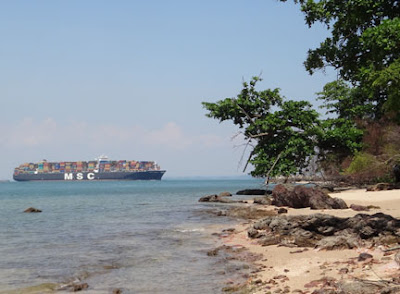What happens when the Southern Expedition gets a day off? Some of us decide to explore the coastal forest of St John's Island and Lazarus Island!
I joined Bian and Kwan Siong and learnt so much from them.
We started first by checking out the Eastern point of St. John's Island. Are there any Critically Endangered Mentigi (Pemphis acidula) growing here? Huge boulders ring this scenic natural point, with the Sisters Islands on the horizon.
Botanists are possibly crazier than zoologists. As Kwan Siong and Bian clamber up rocks and cliffs to gather botanical specimens for the NParks herbarium. Sadly, we didn't find any Pemphis. Instead, there were many shrubs and trees of the invasive Acacia.
We next headed out for Lazarus Island which has one of Singapore's last natural rocky cliffs and rocky shores, cloaked with interesting coastal forest plants. Lazarus is now joined to St John's Island by a causeway. Which is convenient, but has affected the reef life on Lazarus.
We bumped into Dr Jim Lowry who wasn't taking a day off. He was heading off on the Base Camp bicycle with his bucket to check his amphipod traps at Seringat Kias.
Wow, a pretty wild orchid. Fortunately, not considered endangered. Unfortunately many of our coastal forest plants are Critically Endangered because we have so few of these natural coastlines left undeveloped.
Bian found this young Nyireh laut (Xylocarpus rumphii) tree, a Criticially Endangered mangrove tree. There is a big old mother Nyireh tree on St. John's Island. But we didn't have time to visit there. So much more to see and learn!
The Critically Endangered Bonduc (Caesalpinia bonduc) is a very prickly plant! There are only a few plants known in Singapore. I have seen the female plant on Pulau Semakau.
The plant on Lazarus Island is said to be male, and it was blooming!
We also had a look at some of the Pelir musang (Fagraea auriculata) found here. Another Critically Endangered coastal plant. The huge flowers are said to be 30cm across and 'Pelir musang' means 'civet cat's testicles' in Malay, probably referring to the fruits.
Bian points out several lovely Seashore nutmeg (Knema globularia) trees on the shore. These pretty trees are well known at Chek Jawa and are also Critically Endangered.
And a lovely Delek air (Memecylon edule) tree which was blooming and fruiting! This Critically Endangered tree is also found on Pulau Jong, Sentosa, Labrador and some other coastal forests.
Despite lying next to major international shipping lanes, our beautiful natural southern islands still have amazing life both on the shores and in the forests.
As we walked on the northern shore of Lazarus, a view of Kusu Island. There was no time to do an intertidal survey of Kusu Island during the limited low tides during the Expedition. But this shore was surveyed by divers.
Here's a view of Base Camp on St John's Island from Lazarus Island. With parts of the fish farm that lies in the channel between the islands.
The fish farm had stacked a large pile of big pieces of wood on a tree that is already struggling to stay upright. Sigh.
The fish farm also 'parks' its massive equipment on the shore.
Here's how big the equipment are.
We're all man enough to hold umbrellas when it gets too hot! We all learn so much from Bian today, thank you! Kwan Siong also ea lovely bouquet of specimens by the end of our trip.
As we were heading home, Dr Kevin Tilbrook took a photo of us with his phone. I didn't realise this was possible! We looked at my phone and it seems my phone can't do this. :-(
Looking at Facebook posts, it seems some of the other hardworking staff and volunteers of the Expedition also spent time relaxing by cycling and exploring St John's Island. Chay Hoon and Pei Yan tried to snorkel various lagoons at St John's.
Tomorrow, the Expedition resumes with another Deep Dredge and diving surveys.
I hope to resume live updates on twitter as well as to facebook and the Mega Marine Survey facebook page on Monday. So also check out tweets by participants using the hashtag for the Survey #MegaMarine. These are consolidated on the Mega Marine Survey blog.
Volunteer sign up for the Southern Expedition are already closed due to limited places and early logistical arrangements needed for participation.
But no worries, you CAN still join the Survey! Lots of surveys will continue after the Expedition, just at a less frenzied rate. There will be lots of other opportunities for volunteers to participate in dredging, field surveys as well as laboratory sessions. To join the Mega Marine Survey, register your interest in this formand you'll be invited to join the mailing list to receive updates on the Survey and sign up for Survey activities. Also check out the FAQs for more about the Survey.




















